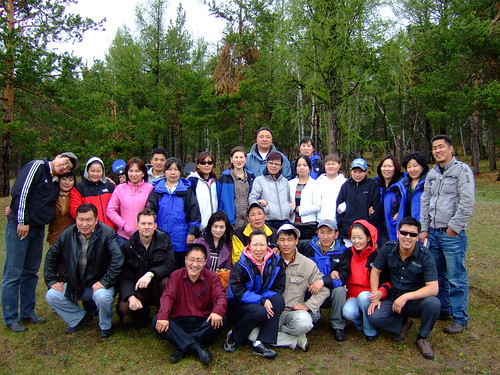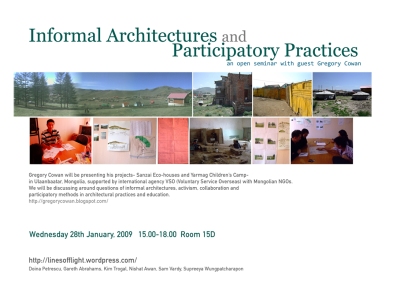 I made it home tired after the Baga Bayan excursion, and having resisted Batbileg's (mathematics teacher and ger district neighbour) insistent invitations for one more drink at the rough-looking local bar at Sapporo.
I made it home tired after the Baga Bayan excursion, and having resisted Batbileg's (mathematics teacher and ger district neighbour) insistent invitations for one more drink at the rough-looking local bar at Sapporo.The time had finally come for architect teacher training, almost by accident. Suvdmaa of the Technical and Technology College sms-messaged me on Sunday night to confirm our Monday 11am training meeting. I agreed, and in the morning rallied our teachers at CTC. The TTK teachers called at 11.45am trying to postpone, while CTC teachers waited, but I called Suvdmaa's bluff, and they finally arrived after midday. Suvdmaa brought Bolorchimeg, a young architect teacher graduate of MUST. I demonstrated mapping a typical Part1 architecture course. I gave each of the two pairs of teachers an A4 sheet and they set to diagramming the architecture courses at CTC and TTK respectively, the basic year progression, semesters, and some of the subject areas.
I have established a great rapport with CTC teachers Bolormaa (Maths) and Tsenguune (Computing teacher), and with their excellent translation abilities and now developed curriculum design interest, they became fine teacher training collaborators.
The purpose of mapping became clear as we explored the complementarity and continuity of the Mongolian course subjects in comparison with the 'typical part1' course. The technical bias of the courses, at the expense of culture and communication, was also discussed, in what was agreed as deriving from the Russian style legacy of these two (largely similar) Mongolian courses. The roles of various teaching methods - lecture, seminar, studio, workshop, assignment, excursion - were compared and contrasted. The Mongolian teachers all took great interest in 'Point of Reference' (Khoa Do ed, 2006) a handbook produced by Perthian architecture and interiors students with Khoa Do. They scrutinised the Curtin course structures, but also teaching and learning tips, and model and project examples with great interest. I wondered aloud whether they could do something similar with their students. I proudly recounted my history with Khoa Do, from his first year as architecture student to teaching colleague, architect collaborator and passed master.
The course comparison showed that the Mongolian architecture courses were comprised of 4 years, eight semesters of 16 weeks each, loosely comparable with the 3 year 'Part1'. Practical experience, they suggested, however, is most problematic, because of the tendency for exploiting student labour and its dubious educational value. I carefully touched on the principle of a 'Professional Experience Record' to monitor the quality of professional experience, but urging the participation of a professional body... (such as the currently 'dormant' Mongolian Architects Association, through committee chair Purev-Erdene Ershuu.)
Bolorchimeg initiated a discussion about professional education for Architects and Urban Designers and I compared the continental European / German-language / perhaps also 'Russian' integral approach to Urbanism, with the Commonwealth / British tradition of Town Planning as a separate discipline. Particularly interesting in this post-socialist context is the Peri-Urban condition, which Purev-Erdene Ershuu's 'Centre for Architectural Design and Research' at MUST addressed in its conference with Vienna University of Technology last year.
The Russian legacy in the Mongolian architecture curriculum and literature was discussed in light of my experience of the generation of Russian-trained Mongolian architects - some still believe the 1965 Russian edition of Neufert to be suitable for 21st century Mongolia. Bolorchimeg begged to differ and wrote down references we discussed, to Bat-Od (UB 2007) and Ching's 'Form Space and Order', whose publisher Wiley has kindly offered a free chapter download. Bolorchimeg also copied down my hand-made wall chart where Mongolian architecture students mapped in Mongolian the equivalent of the 'RIBA' work stages of an architectural project - from go to whoa.
Ziemlich muede nach unserem Ausflug, und nach dem ich Einladung im denkwuerdigen Lokals von Batbileg - meinem Mathematik-lehrer kollege und Ger-bezirk nachbar - entkam, ging ich nach Hause.
Endlich- fast zufaellig- kam eine chance fuer das 'Architekten-innen-lehrerinnen-tranieren'. TTK lehrer Suvdmaa hatte mich Sonntag am Abend ein sms-message gesandt, um unseren montagiges Termin zu bestaetigen. Einverstanden, rufte ich dann die CTC Lehrerinnen zusammen. Das TTK-partie telefonierte um 1145, um verschub zu versuchen, da war ich aber nicht einverstanden - da kamen Sie dann trotzdem nach dem mittag. Suvdmaa brachte Bolorchimeg mit, eine junge beim MUST absolvierte Architekturlehrerin. Ich stellte das aufzeichnen eines typiches Part1 Architektur-kurs vor. Dann gab ich die zwei Lehrerinnen-paare je ein Blatt A4, und sie begannen die Architektur-kurse - jeweils CTC und TTK - in Diagrammform grob zu zeichnen - einfache fortfolge, semester-struktur, und einige fachbereiche.



No comments:
Post a Comment